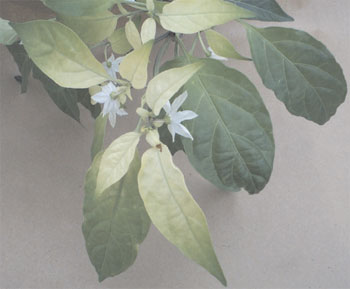Iron Deficiency
The typical symptoms of iron deficiency in plants are chlorotic leaves. Often the veins remain green
whereas the laminae are yellow, and a fine reticulate pattern develops with the darker green veins
contrasting markedly with a lighter green or yellow background (Figure 11.2). In cereals, this shows up as alternate yellow and green stripes (Figure 11.3). Iron
deficiency causes marked changes in the ultrastructure of chloroplasts, with thylakoid grana being
absent under extreme deficiency and the chloroplasts being smaller
(27,28). As iron in older leaves,
mainly located in chloroplasts, is not easily retranslocated as long as the leaves are not senescent,
the younger leaves tend to be more affected than the older leaves (Figure 11.4). In extreme cases
the leaves may become almost white. Plant species that can modify the rhizosphere to make iron
more available can be classified as iron-efficient and those that cannot as iron-inefficient. It is among
the iron-inefficient species that chlorosis is most commonly observed.
 |
| FIGURE 11.2 Iron-deficient cucumber (Cucumis sativus L.) plant. |
 |
| FIGURE 11.3 Iron-deficient corn (Zea mays L.) plant. |
 |
| FIGURE 11.4 Iron-deficient pepper (Capsicum annuum L.) plant. The young leaves are yellow, and the older
leaves are more green. |







